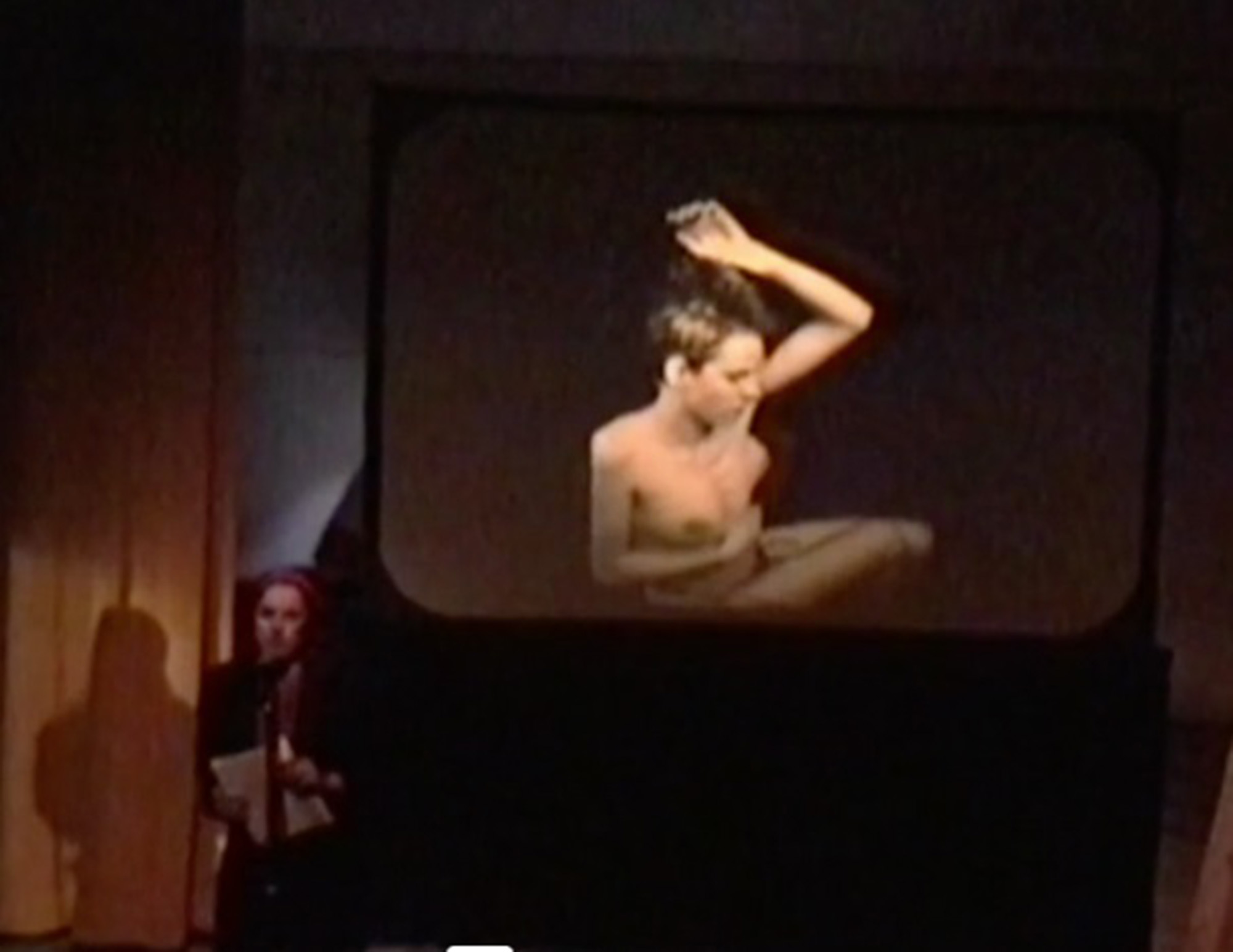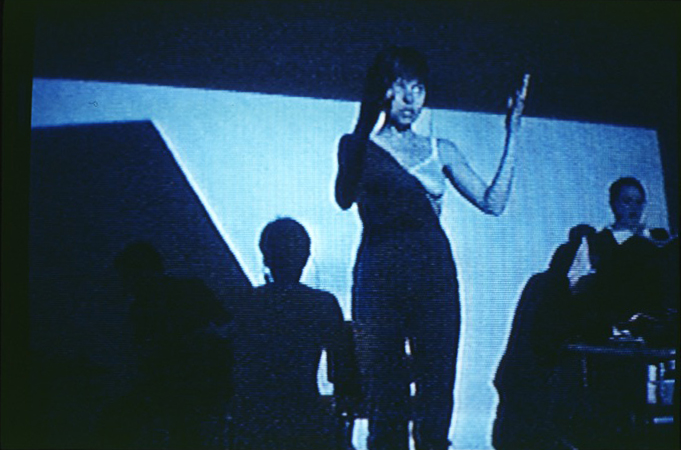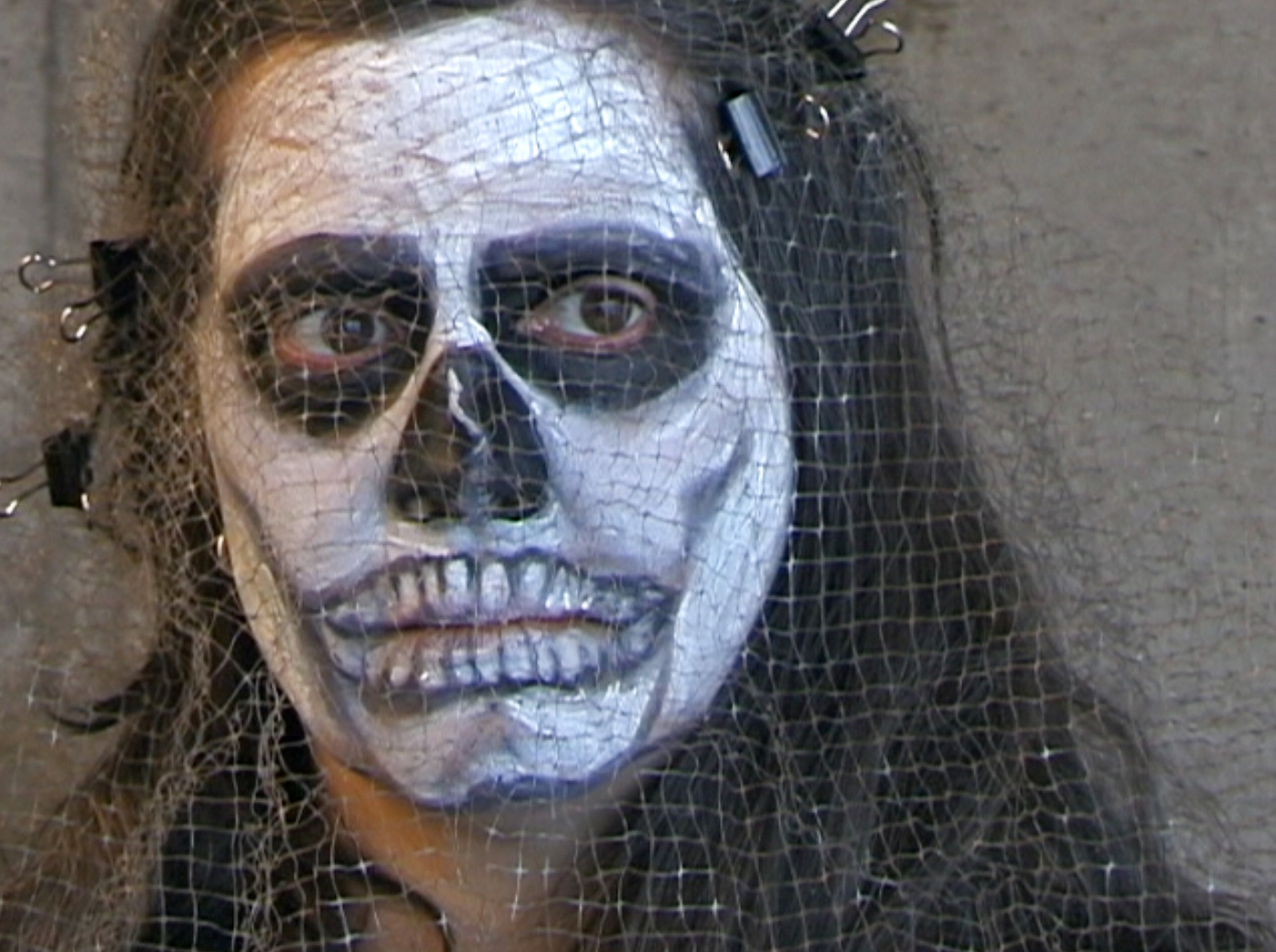Kiss & Tell left an indelible legacy for queer artists and activists to follow and expand upon. The collective’s storytelling through photography, performance art, and writing brought visibility to lesbian experiences and queer activism in Canada and beyond. While Kiss & Tell’s works were in reaction to a particular place and time, their oeuvre remains just as fresh, poignant, cathartic, revelatory, and provocative today as it was more than two decades ago.
Queering the Archive


When I first started research for this book, I thought I would have to piece together information about Kiss & Tell’s performances from articles and interviews. Fortunately, when I met with Vancouver-based filmmaker and digital storyteller Lorna Boschman (b.1955), she brought out a box of video and audio recordings of the collective’s performances from one of her closets. Aside from the contents of this box, snippets of these performances could only be viewed in Before the New Millennium, a twenty-six-minute retrospective documentary film of Kiss & Tell’s work created by Boschman in 2007. The film included excerpts from the True Inversions, 1992, That Long Distance Feeling: Perverts, Politics & Prozac, 1997, and Borderline Disorderly, 1999, performances, as well as their 1994 book, Her Tongue on My Theory: Images, Essays and Fantasies. Boschman shared with me how difficult it was to make this last video because she and Persimmon Blackbridge had broken up by this time, yet she felt it needed to be done to preserve the collective’s legacy.
I am equally grateful that Susan Stewart donated her extensive collection of Kiss & Tell artworks, audio and video recordings, reviews, articles, scripts, and ephemera to the Special Collections and Rare Books Library at Simon Fraser University (SFU) in Burnaby. Susan explained how her archive ended up at SFU:
I wrote to the national [gay and lesbian] archives in Toronto first and offered them the Kiss & Tell holdings. They never responded, so I didn’t follow up. I wasn’t aware of the BC Gay and Lesbian Archive. This would have been about 20 years ago, and it seemed at the time that the national archive was really only interested in gay [male] content. SFU happened later because El Chenier contacted me… and they arranged [for] Special Collections to get in touch with me about our holdings. I agreed because they are very cool and have a great collection that is progressive politically: punk movement, queer archives, poets, etc., plus I am an alumni so it felt like a good fit.
If Susan and Lorna had not amassed and kept these archives, my book would not exist in its current form.

The importance of queer archives cannot be overstated. As Lizeth Zepeda, a diversity librarian and the archivist at Loyola Marymount University in Los Angeles, wrote: “Traditionally, the archival institution has reaffirmed hegemonic power structures by erasing and ignoring histories of marginalized communities. [They] are complex, messy, disruptive, and extremely personal because they delve into the intimacies of gender and sexuality.” This in part explains why queer activists have been compelled to create their own archives to preserve their histories.
-
“Dip me in Maple Syrup and THROW me to the LESBIANS,” metal button, c.1990–99
4.5 cm (diameter)
The ArQuives: Canada’s LGBTQ2+ Archives, Toronto
-
don’t be a wussy love yer pussy,” metal button, n.d.
Manufactured by Bendy Buttons, 2.5 cm (diameter)
The ArQuives: Canada’s LGBTQ2+ Archives, Toronto
-
“WOMEN’S BATHHOUSE DEFENSE FUND: PUSSIES BITE BACK,” metal button, c.2000
4.5 cm (diameter)
The ArQuives: Canada’s LGBTQ2+ Archives, Toronto
Initially called the Canadian Gay Liberation Movement Archives, the first queer archive in Canada was founded in Toronto in 1973 by the gay newspaper The Body Politic. Now known as The ArQuives, it “is the largest independent LGBTQ2+ archive in the world and the only queer archive in Canada with a national scope.” Regional queer archives also sprang up across Canada in the 1970s and 1980s, including the B.C. Gay and Lesbian Archives (in 1976) and the Quebec Gay Archives (in 1983). These institutions were created as an antidote to the invisibility of queer people throughout Canadian history. But despite having “lesbian” in their names, many of them tended to focus on gay male materials, at least initially. This led women to establish their own archives, such as the Lesbian Archives of Quebec (in 1983).
Queering the archive upends traditional opinions on what is considered valuable and worthy of preservation. For example, The ArQuives, where I started my research for this book, has a vast collection of ephemera, including promotional flyers, clothing, mugs, keychains, greeting cards, magnets, and buttons. As feminist studies professor Anjali Arondekar has noted, “queer archives are all about the soiled and untidy—about leaving your dirty chonies [underwear] on the kitchen table.” Creating and maintaining a queer archive is an important strategy in the battle to share lesbian and sapphic experiences. It allows future generations to learn about, and remember, the lives of lesbian elders, and how they fought for the rights we have and are still struggling to maintain.
The Legacy of Kiss & Tell
One thread that connects Kiss & Tell’s works is a kind of interrupted and disrupted storytelling, where competing fragments live side by side, ringing dissonant chords rather than being tidied away in a singular resolution. In Drawing the Line, 1988–90, each photograph recounted a moment from a fabricated sexual encounter captured by the camera. In one photograph, a woman was clad in a garter belt with stockings and tight black underwear that showed off her ass cheeks. Through the inverted V of her legs, we see another woman lying on the floor, handcuffed to the wall. It is easy to discern who is in control in this encounter, but what negotiations took place to determine the boundaries of this power play? What will happen next? Will the women maintain the roles of dominant and submissive, or will they switch? This is the magic of the photograph. It captures a singular moment and leaves us to imagine the rest.
Kiss & Tell’s performances were full of stories: monologues and narratives that bounce back and forth between all three members of the collective, and visual accounts told through projections of video and photographs, text, and paper puppets. While sexuality was threaded throughout Kiss & Tell’s work, it wasn’t the only throughline. The performance That Long Distance Feeling: Perverts, Politics and Prozac, 1997, for example, contained anecdotes about class and the economic realities facing many contemporary artists.


In one section of the That Long Distance Feeling performance, against a backdrop of heavy bass electronic music and images of buildings zipping by on a projection behind her, Susan explored the haves and have-nots from the perspective of an artist and a single mother. She hypothesized about how to live without buying from corporations run by people like Bill Gates: “Single mothers could be the role models. They are expert at living without…. No savings, no assets, no mutual funds, no Old Age Security. No money, no money, no money. Running on empty.” In another monologue, Persimmon talked about the monotony of her cleaning job. Thankfully, the boring every day was fractured one day when a “butch university professor” (and her cleaning client’s ex) stopped by and they had sex. “I’ve never been fucked as someone’s cleaning lady before. Mostly I got fucked as a semi-famous artist. After twenty years of cleaning houses, it was about time.” Some of Persimmon’s and Lizard Jones‘s monologues in That Long Distance Feeling were taken from their 1997 novels Prozac Highway (Persimmon) and Two Ends of Sleep (Lizard).
The artworks of Kiss & Tell were an antidote to the misunderstanding, stereotyping, misinformation, and vilification of queer people. They asked questions without providing answers so that audiences were compelled to reflect on what was happening around them. The legacy of Kiss & Tell is a call for freedom of representation, sexuality, and gender fuckery. The collective is an important reminder of why we need to remember our queer roots—especially considering recent increased transphobia and the backlash against lesbian and queer identities in Canada.
-
Kiss & Tell, photographic projections from That Long Distance Feeling: Perverts, Politics & Prozac, 1997
Multimedia performance
Kiss & Tell Fonds, Special Collections and Rare Books, Simon Fraser University Library, Burnaby
-
Kiss & Tell, photographic projections from That Long Distance Feeling: Perverts, Politics & Prozac, 1997
Multimedia performance
Kiss & Tell Fonds, Special Collections and Rare Books, Simon Fraser University Library, Burnaby
-
Kiss & Tell, photographic projections from That Long Distance Feeling: Perverts, Politics & Prozac, 1997
Multimedia performance
Kiss & Tell Fonds, Special Collections and Rare Books, Simon Fraser University Library, Burnaby
While lesbian visibility has increased significantly in art and popular culture since the 1990s, there is still much work to be done. According to a recent study from the University of Ottawa, suicide rates among transgender and nonbinary teens are at crisis levels. Transgender youth are five times more likely to think about suicide and 7.6 times more likely to have attempted suicide than cisgender youth. LGBTQ2S+ people are five to ten times more likely to attempt suicide than cisgender and heterosexual individuals. Given these statistics, it is clear that seeing queer stories in history, art, and popular culture still matters today. Queer youth need to witness diverse representations of queerness by queer artists and storytellers to know they are not alone. A 2024 Ipsos survey of Canadians found that support for queer people being open and visible had dropped twelve per cent from 2021. Over the past few years, the Human Rights Campaign has been tracking increased numbers of murders of trans and gender-nonconforming people. In 2021, there were 375 reports of trans people being killed around the world (and many more deaths that go unreported). In the U.S. in 2024, states put forward or passed 530 bills that negatively affected queer health, education, civil rights, and trans rights. In January 2024, the Alberta government announced policies that would limit gender-affirming health care for young people, make it impossible for them to alter their names or pronouns in school without parental consent, and require parental consent and the ministry of education’s approval for any discussion of gender identity, sexual orientation, or sexuality in schools.

Queer people and allies continue to stand up against injustice. For example, in May 2023, the Brandon School Division in Manitoba rejected a call to remove books about sexuality and gender identity from its school libraries. On April 29, 2023, a group of lesbian motorcyclists formed a human chain around the library in Parkhill, Ontario, for a drag queen storytime event. Patricia Ginn, one of the bikers determined to protect the drag queens and the families in attendance, said of the anti-LGBTQ2S+ protesters, “They were in our face, pushing and shoving, screaming, calling us everything they could think of. They actually went up to several members who were walking in with their children and called them pedophiles.”
Given the violent backlash against queer people in North America and the rise in anti-LGBTQ2S+ legislation, we need to learn from artists and activists who have stood up against censorship and limitations placed on queer people. When our rights are under threat, we need to advocate for ourselves. Kiss & Tell has shown that art can be a potent medium for protest, dialogue, self-discovery, and self-expression—and for speaking truth to power. Art can be a venue for pleasure activism, by exploring joy, laughter, healing from trauma, sex, body positivity, and increased understanding. We need to continue to fight against the erosion of our equal rights and the hatred and misinformation that is being fomented against us.
An Afterword by Kiss & Tell

We were activist artists working outside the academy, art institutions, and conventional norms. We critiqued these systems while borrowing from them and maintaining some ties to them. We put ourselves in a critical position and occasionally held up mirrors to current cultural and art theories. We were also angry. We wanted social change and justice. We spoke out from the margins, unwilling to accept our status as oppressed outsiders. We took up representational space, loudly, even though we weren’t invited to the party.
Our work wasn’t just about sex; it was multi-levelled and very complex. Our sex work got attention, and once we had that attention, we deepened and complicated the narrative to include class analysis, trauma, ableism, sexism, oppressive political systems and laws, and love. We were successful outside the system because our community and audience adored us and supported us. Our work was a fourteen-year dialogue with our community of lesbians/queers, feminists, political activists of many stripes, some cultural theorists and academics, usually queer, and the mainstream curious. This community was spread around the globe, although our local community was our lifeblood.
The images in Drawing the Line, 1988–90, have depths beyond the obvious binary of like, don’t like, etc. The images grouped as narrative fragments pointed to complex relationships involving desire, sex, transgression, rage, and freedom. They were glimpses into bigger truths and stories. The formal aspects of the work that relate to art/photography tropes are largely missed. Philosophical, political, art historical, critical theory (the frame, gaze, etc.) were all in the mix. The sex distracted from this, but we didn’t mind. The point is that we were intellectually rigorous in our approach and spent hours and hours in the studio. Our work reflects this; it stood up and it stood out (pun intended). It was the only way we would get any traction at all, since the art world steadfastly ignored us.
-
Kiss & Tell, photographic projections from Corpus Fugit, 2002
Multimedia performance
Kiss & Tell Fonds, Special Collections and Rare Books, Simon Fraser University Library, Burnaby
-
Kiss & Tell, photographic projections from Corpus Fugit, 2002
Multimedia performance
Kiss & Tell Fonds, Special Collections and Rare Books, Simon Fraser University Library, Burnaby
-
Kiss & Tell, photographic projections from Corpus Fugit, 2002
Multimedia performance
Kiss & Tell Fonds, Special Collections and Rare Books, Simon Fraser University Library, Burnaby
None of this was easy because we did not have institutional support. We all hustled side gigs throughout our tenure, including cleaning houses, subsisting on student loans, working in non-profits on short-term funds, living as cheaply as we could in co-ops and substandard housing, etc. We ended up exhausted. Who wouldn’t?
The performance space was where we met our audiences face to face. The energy at our shows was incredible—the anticipation, the excitement, the longing, and the edge. It was an energy exchange; it was transformative, a direct experience for everyone there. But at the very root was trauma. We stood up there and ripped the Band-Aids off our own trauma, and we used humour, affection, a lot of interesting imagery, etc., to soothe the pain and triggering that occurred. As performers during some of the more intense monologues, you could have heard a pin drop in that room, as if everyone was just holding their breath. The queer community was, and still is, an extremely traumatized community. In the 1992 True Inversions video, it is front and centre for anyone to see—as it was in all our shows. That woman who ran running from the room during a performance of Corpus Fugit, 2002, was triggered and acted out what a lot of others were feeling. We pushed into edges of collective trauma by exposing our own and allowing for a little release. Dressing this up in sexiness, flirtation, laughter, and fun is what made it healing in a way. Only in retrospect can this even be articulated. At the time, it was too raw, too painful, too dangerous, and we didn’t have a language for healing.


 About the Author
About the Author
 More Online Art Books
More Online Art Books
 Acknowledgements
Acknowledgements